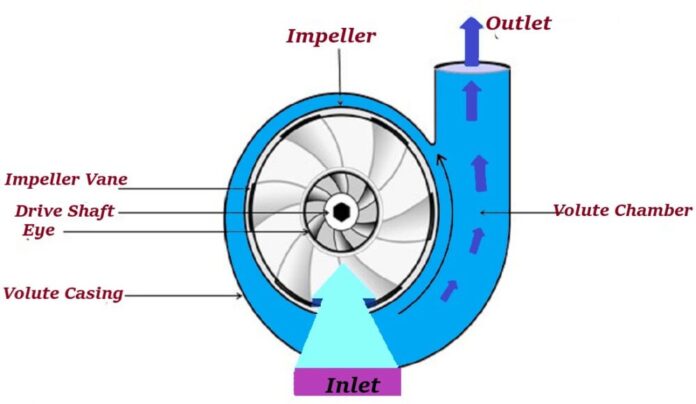A centrifugal pump is a mechanical device that uses centrifugal force acting on a liquid to convert mechanical energy into hydraulic energy. It is the most popular and widely used type of pump for bottom-to-top liquid transfer, finding applications in agriculture, municipal services, industry, power plants, petroleum, mining, chemicals, pharmacy, and many other fields. When a particular mass of liquid rotates under the action of an external source, it rejects with the help of the rotating centrifugal shaft. It presses on ahead, causing it to rise to a higher level. Thus, centrifugal pumps can be utilized with higher performance for viscous and non-viscous liquids.
These pumps have higher efficiency than reciprocating pumps. In various applications, centrifugal pumps often require high-quality industrial hoses to connect the delivery pipe, suction tube, and filter to the appropriate fluid intake or discharge points. These industrial hoses ensure smooth fluid transfer, flexibility, and durability, allowing the centrifugal pump system to perform its intended functions across different industries and sectors effectively.
When a particular mass of liquid rotates under the action of an external source, it rejects with the help of the rotating centrifugal shaft and presses on ahead, causing it to rise to a higher level. Thus, centrifugal pumps can utilize with higher Performance for viscous and non-viscous liquids
Centrifugal pump components
A centrifugal pump has the following major components:
1) Impeller
It is a wheel or rotor with a series of vanes or blades curved backward. It locates on the shaft, which couples to an external power source. The shaft transfers liquid energy to the impeller by rotating it.
The impeller of a centrifugal pump spins rapidly to transfer speed to the pumped liquid. These pumps have a fast-rotating propeller. This impeller transfers speed to the liquid in the pump, much like a boat’s propeller transfers speed to lake water. The casing is part of the device that receives, accommodates, controls, and sends in useful orientation. Each impeller has one or more blades that extend from the center or hub of the wheel to the outside diameter of the wheel.
As the impeller spins, the centrifugal force causes the liquid to move rapidly from the center of the impeller, along the blades, and then out of the impeller at the outermost diameter. The result is that the pumped liquid leaves the circumference of the wheel at a very high speed.
Impellers have three types:
- Open Impeller
- Semi-enclosed Impeller
- Enclosed Impeller
2) Casing
The centrifugal pump casing is an integral part of the pump, converts all the speed generated by the rotating impeller into a controlled and steady flow, and manages it through the pressure point outside the pump. The most ordinary type of casing is spiral, which looks like a snail shell.
The pump runner is placed in the spiral casing. On the contrary, the wheel’s position is such that the outside diameter of the wheel is closest to the spiral at the level of the outlet opening. The point at which the wheel is closest to the spiral is called the water cut angle.
From the water cut angle, the distance between the spiral and the wheel gradually increases as you go around the wheel until the exit point is reached. Due to this constant expansion of the area around the wheel, the pressure changes from the smallest space to the largest, and the increase in pressure pushes the liquid out of the exit point.
3) Delivery Pipe
It is a pipe that’s lower end connects to the outlet of the pump and carries the liquid to the required height. A valve is placed near the pump’s outlet in the supply line to control the flow from the pump to the supply line.
4) Suction Tube and Strainer
The suction tube connects to the inlet of the impeller, and the other end submerges in the water tank. At the end of the water, it consists of a bottom valve and a Strainer. The bottom valve is a one-way valve that opens upward. The strainer uses to filter unwanted particles in the water to prevent clogging of the centrifugal pump.
Working of Centrifugal Pump
The first step in the operation of a centrifugal pump is priming. The priming is the act of sucking the jacket of the pipe and positioning the fluid and pumped liquid from the pump so that all the air at the pump position deflates without leaving any air. The need to prime a centrifugal pump is due to the fact that the pressure generated by the impeller of the centrifugal pump is proportional to the density of the liquid in contact with it.
Check out: What is a Septic System? Types and Components
Once the pump is started, the supply valve remains closed, and the motor starts to turn the impeller. The supply valve is kept closed to reduce the size of the valve when open. After this, the fluid flows radially outward through the impeller vanes on the outer circumference. Centrifugal force creates a high-speed vacuum around the outer circumference. As a result, the liquid flows from the sump to the eye of the impeller through the suction pipe, which replaces the long outlet on the central circumference of the impeller, with which the liquid is raised to the required height through the supply pipe.
Application of Centrifugal Pumps
- Oil and crude oil, sludge, pumped sludge: These pumps utilize in oil refineries and power plants.
- Industrial industry and fire fighting: Heating and ventilation, boiler feedwater applications, air conditioning, pressurization, sprinkler systems.
- Waste management, agriculture, and production: wastewater treatment plants, municipal industry, drainage, natural gas treatment, irrigation, and flood protection
- Pharmaceutical, chemical, and food industries: paints, hydrocarbons, petrochemicals, cellulose, sugar refining, food production.
- Various industries (manufacturing, industrial, chemical, pharmaceutical, food, aerospace, etc.) – for low temperatures and refrigerant

